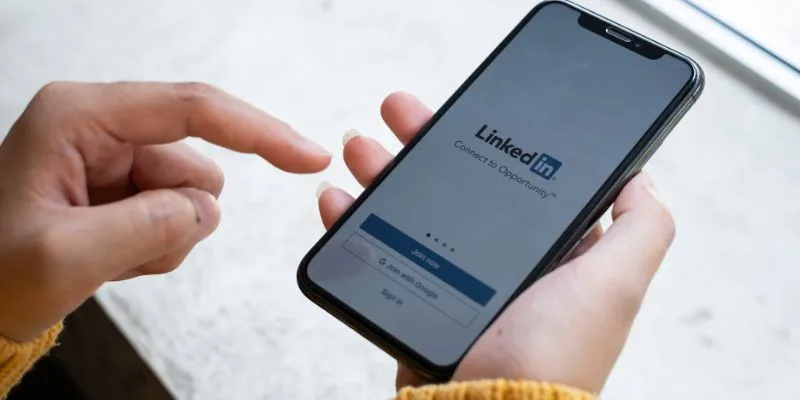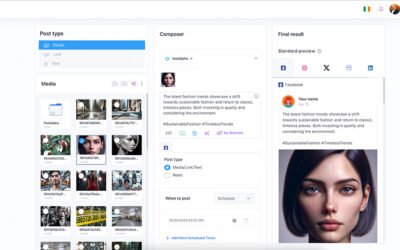Diving Into LinkedIn Groups: Can a LinkedIn Business Page Join Groups?
Let’s be real. Most actions on LinkedIn, especially those on company pages, are driven by the desire for effective marketing. From navigating sales accounts to showcasing products and services, and even engaging with posts, it’s all about brand visibility. Now, there’s a buzz around LinkedIn groups being a game-changer for marketing.
But here’s the million-dollar question: Can a LinkedIn business page join groups? Spoiler alert: No

The Rationale Behind the Restriction
LinkedIn groups are carved out as a space for individuals to connect, share content, and collaborate. It’s not a place for companies to feature their brands.
A little surprising, right? But it just means that marketing teams have to get more savvy.
While company pages might be on the sidelines, individual users can dive right in. And there’s a tonne of ways to help amplify brand presence in these groups.
Groups: The Branding Goldmine
Think of LinkedIn as a dynamic professional symposium, teeming with professionals hungry for industry insights. By immersing yourself in these groups, you’re not just tapping into potential leads, you’re also cementing yourself as an industry leader.
The trick? Find groups that your brand resonates with. After all, there’s no point in joining a group for farmers when you’re trying to sell medical supplies.
It’s all about joining groups that resonate with your brand’s ethos.
Pro tip? Scout out the groups that your potential clients, loyal customers, and industry leaders are part of.
Once you’re in, it’s showtime.
Share insightful content – be it enlightening articles, step-by-step guides, or thought-provoking posts. The paradigm of social media marketing is evolving; it’s veering towards engaging micro-communities rather than broadcasting to the masses.

Harnessing Groups for Problem-Solving
Another great feature of LinkedIn groups is their ability to problem solve. We all know that problems occur in all walks of life, and business, and when they do, you can ask for advice on LinkedIn.
By sharing a problem, you’ll not only find a solution but you’ll also be trusted in the spotlight and will grab the attention of people who didn’t notice you before.
When you ask questions in a group, you’re guaranteed to get people visiting your page and your company page to see what you have to offer.
Building Bridges in Groups
LinkedIn groups are a networking nirvana. From potential clients and peers to industry mavens and prospective investors, the possibilities are endless.
But here’s the catch: it’s about depth, not breadth. Spreading yourself thin across numerous groups might dilute your impact. Focus on a select few and make your presence felt.
Treading with Tact
While the urge to broadcast every tidbit from your company page or promote your offerings might be strong, restraint is key. Over-promotion can backfire, denting your brand’s image and even leading to a group exile. Striking the right balance between engagement and promotion is the name of the game.
Understanding LinkedIn Groups

What are LinkedIn Groups?
LinkedIn groups are dynamic virtual communities within the landscape of professional networking, where like-minded professionals with similar interests, industries, or goals can come together to discuss, share insights, and foster meaningful relationships.
These digital communities transcend geographical boundaries, providing a space for LinkedIn users to delve into their passions, explore niche topics, and stay abreast of the latest trends in their fields.
By joining relevant groups, businesses can gain access to a targeted audience and establish their presence in their industry.
Difference between LinkedIn Company Pages and Groups
LinkedIn company pages and groups serve distinct yet complementary purposes within the realm of professional networking.
A company page functions as a digital storefront for businesses, where they can showcase their brand, products, services and company culture. It’s an ideal space to reach a broad audience and build brand awareness.
A LinkedIn group, on the other hand, is more like a virtual meeting room where LinkedIn users can foster discussions with others who have shared interests or goals. Groups provide a platform for networking, knowledge-sharing, and in-depth industry conversations.
While Company Pages are primarily one-way communication tools, Groups facilitate two-way interactions and community building. They are perfect for niche discussions, Q&A sessions, and establishing thought leadership.
To maximize your LinkedIn presence, consider combining the strengths of both Company Pages and Groups, tailoring your approach to your specific goals, whether it’s brand exposure or engaging with a targeted community of professionals.
Leveraging LinkedIn Groups for Business Growth

Finding and Joining Relevant Groups
One of the first steps to leveraging groups for business growth is finding and joining relevant groups.
Start by conducting a strategic search using keywords relevant to your business niche or professional interests. Once you’ve identified potential groups, take a close look at their membership, activity level, and the quality of discussions. Seek out those with engaged communities and a balance of members, including potential clients, industry peers, and experts.
Joining such groups can be a game-changer for your business, offering you a platform to share your expertise, build relationships, and even discover new opportunities.
Remember, it’s not about quantity but relevance; being an active, valuable participant in a few targeted groups can yield far greater benefits than passively engaging in numerous unrelated ones. So, don’t just collect group memberships like badges—strategically curate your LinkedIn group portfolio to drive real business growth.
Engaging with Group Members
Once you’ve joined relevant groups, it’s important to actively engage with other group members.
These digital communities are treasure troves of industry-specific insights and connections waiting to be tapped. Start by actively participating in group discussions, offering valuable insights, and posing thoughtful questions.
Showcase your expertise without overtly promoting your business, fostering credibility and trust among your peers. Moreover, reach out to fellow members individually to establish meaningful connections and nurture relationships.
When done authentically, this engagement can lead to collaborative opportunities, potential partnerships, and even new clients. Remember, in the world of LinkedIn Groups, the more you give, the more you’re likely to receive in return, making it a powerful tool for business growth.
Leveraging LinkedIn Groups for Marketing Strategies
Groups can be a powerful tool for promoting your brand and services.
By joining relevant groups and engaging thoughtfully, you can establish your brand as an industry leader and build trust among potential customers. Share valuable content, insights, and solutions that resonate with the group’s interests, and position your company as an authority in your niche.
In addition to sharing content, you can also leverage them for lead generation and driving traffic to your website. Include links to your website or landing pages in your posts or comments, directing interested group members to learn more about your business.
You can also use group discussions to generate leads, gather feedback or conduct market research, gaining valuable insights from your target audience.
Just remember, it’s not about blatant self-promotion but about providing genuine value to the community. When executed effectively, LinkedIn Groups can be a vital element of your marketing strategy, fostering brand awareness, lead generation, and lasting customer relationships.
Becoming a Group Manager
Becoming a group manager on LinkedIn can offer additional benefits and responsibilities.
As a Group Manager, you gain the power to curate a thriving community of like-minded professionals around your industry or niche. This not only positions your brand as an authoritative figure but also provides a direct channel to engage with your target audience.
You can foster meaningful discussions, share valuable content, and subtly promote your products or services to an attentive and receptive audience. Moreover, by having your own group, you have the advantage of gathering insights, trends, and customer feedback directly from your group members, helping you tailor your marketing strategies and refine your products or services.
Maximizing the Potential of LinkedIn Group

Showcasing Your Expertise through Group Discussions
Maximizing the potential of a LinkedIn Group means more than just being a passive member; it’s about actively showcasing your expertise through engaging group discussions.
These digital forums are like stages where you can shine as a thought leader in your industry. By offering insightful, well-thought-out comments and responses to discussions, you not only demonstrate your knowledge but also contribute to the collective learning of the group. This establishes your credibility and expertise, making you a go-to resource for fellow members seeking advice or insights.
Additionally, it paves the way for valuable connections and opportunities to emerge. Remember, your contributions should be informative and non-promotional, focused on genuinely helping others and adding value to the group’s conversations.
When you consistently share your expertise in LinkedIn Groups, you not only elevate your personal brand but also position yourself as a trusted authority in your field, a reputation that can significantly benefit your professional journey.
Networking and Collaborating with Other Group Members
Groups offer a unique opportunity to network and collaborate with other professionals in your industry. By engaging with other group members, you can find potential partners, clients, or even collaborators for projects and initiatives.
Actively participating in group discussions and providing valuable contributions can help you establish connections and build relationships with group managers and other professionals.
To effectively network and collaborate with other group members, start by reaching out to individuals who have shared similar interests or goals.
Connect with them on LinkedIn and send a personalized message introducing yourself and expressing your interest in collaborating or networking. You can also attend virtual events or webinars organized by the group to meet other members and expand your network. By actively engaging with other group members and nurturing those relationships, you can unlock new opportunities for your business.
Best Practices for LinkedIn Groups
Engaging in Group Discussions

It’s not just about participating on this social network; it’s about making a meaningful impact.
Start by actively listening to the group’s pulse—understand the prevailing topics and pain points. When you join the conversation, craft responses that are insightful, respectful, and add value. Share your expertise without being overly self-promotional; this will establish you as a trusted authority within the group.
Don’t just stop at comments—initiate discussions on relevant, timely topics to spark engagement. Consistency is key; regularly contribute and stay engaged to maintain a visible presence.
Finally, remember that LinkedIn Groups are about building relationships, not just collecting connections. Connect with fellow members outside of the group to deepen your network.
Sharing Relevant and Engaging Content
Sharing relevant and engaging content is another effective way to utilize LinkedIn Groups. By creating and curating content that is valuable to group members, you can position yourself as a trusted resource in your industry.
This can be done by sharing articles, blog posts, infographics, or any other form of content that provides insights and knowledge.
When sharing content, make sure it is directly related to the group’s interests and focus. This will increase the chances of engagement and interaction with other members. Additionally, consider creating content specifically for the group, such as exclusive industry reports or case studies.
This will not only showcase your expertise but also provide unique value to group members.
Leveraging LinkedIn Groups for Employee Engagement
Leveraging LinkedIn Groups for employee engagement is a strategic move that can enhance workplace culture and drive professional growth within your organisation.
These groups offer a dynamic platform for employees to connect, share insights, and foster a sense of belonging. By creating or participating in groups tailored to specific teams, departments, or company-wide interests, you empower your workforce to engage in meaningful discussions, share industry trends, and seek advice from their colleagues.
This not only encourages collaboration but also amplifies your company’s collective knowledge base.
It also allows employees to showcase their expertise, reinforcing their sense of value and boosting morale. Overall, LinkedIn Groups can serve as a powerful vehicle for nurturing a vibrant, engaged, and tightly-knit employee community, ultimately contributing to the success and growth of your organisation.
Promoting Your Company Page within Groups
Integrating your company page and group strategies is crucial for maximizing the potential of LinkedIn Groups. You can do this by promoting your company page within the groups you are a part of.
Encourage group members to follow your page to stay updated on your company’s latest news, updates, and content.
To promote your company page effectively, make sure to share valuable content from your page within the group discussions. This can include blog posts, webinars, product updates, or any other content that is relevant to the group’s interests. By providing value through your company page, you can attract more followers and potential customers.

Wrapping Up
So, to circle back – can a LinkedIn business page join groups? The answer’s a resounding no. But that doesn’t dim the potential of these groups for brand elevation. With a strategic approach, LinkedIn groups can be your brand’s best friend.
How to Show as offline on Instagram
Heads up: Your Instagram buddies can see when you’re online! Imagine this: You’re chilling, scrolling through Reels, when a friend starts bombing you with not-so-funny memes. The endless pinging is enough to drive anyone mad. Worse still, they can see you’re online...
What’s new in V2: A look at the new features launched in Feedalpha
First, a note from the CEO At its core, Feedalpha has always been a content curation and social media management platform that helps users stay updated with the latest trends and topics relevant to their industry or personal interests. We grew the business to 11,000 +...






